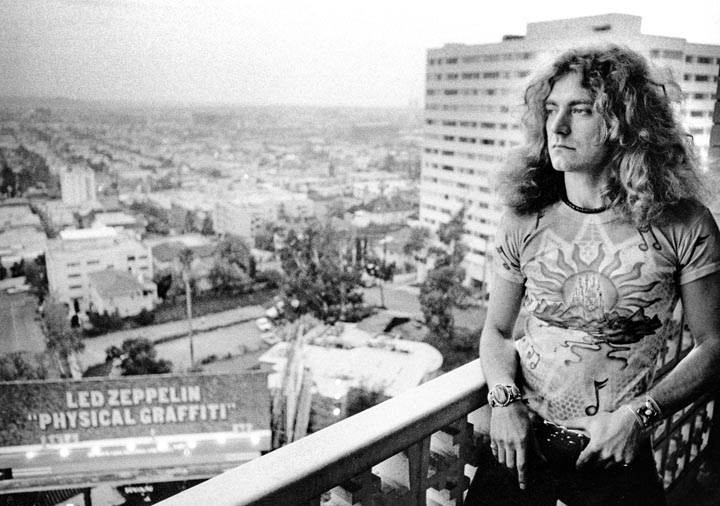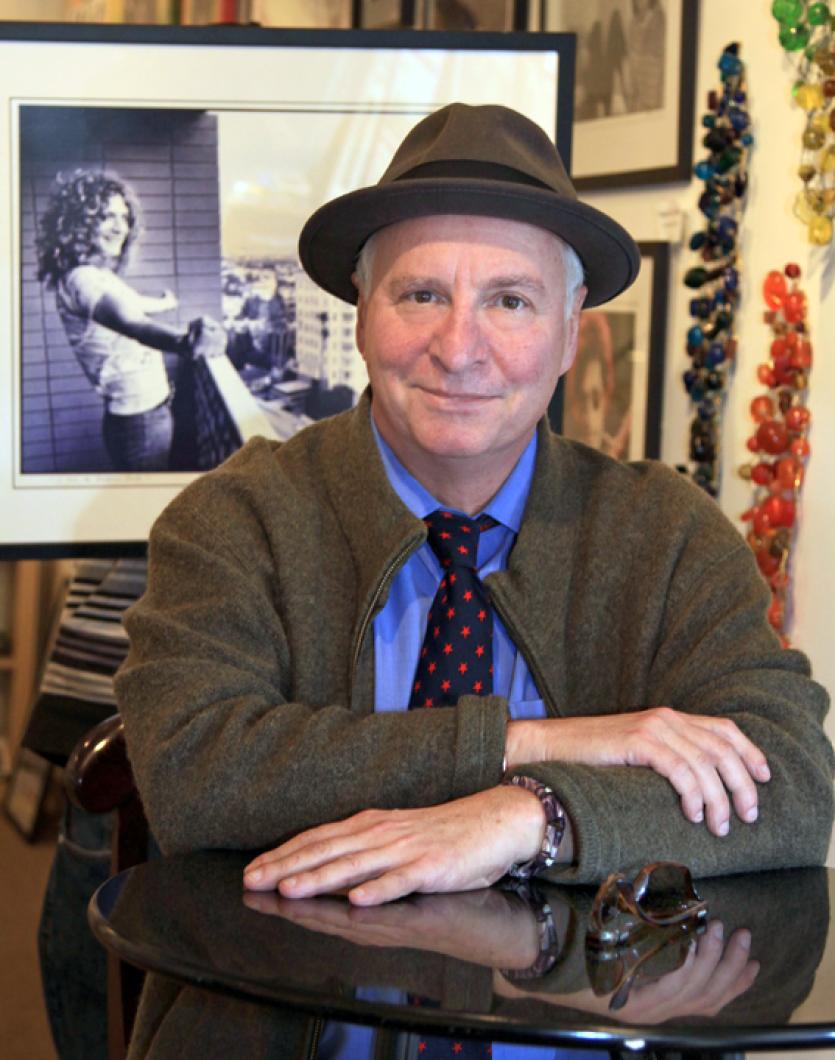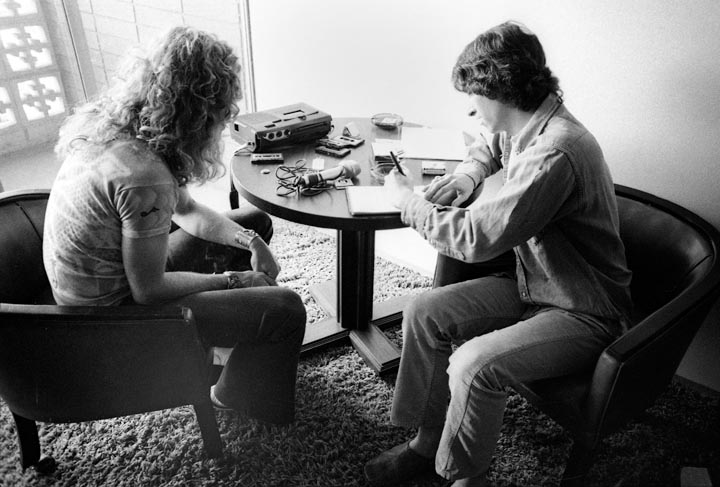In 1985 the rock journalist Stephen Davis wrote a book about Led Zeppelin called Hammer of the Gods. Mr. Davis traveled with the band during their 1975 Physical Graffiti tour and witnessed the band members up close at what many say was the height of their creative powers. The book became a New York Times bestseller. The band hated it.
“It sort of outed them as junkies and people who brutalized other people,” Mr. Davis said. “But at some point while I was writing that book I said, look, I can either be a journalist here or a groupie. And which one’s going to be in print for 25 years? Not the groupie version.”
That book was not based on Mr. Davis’ notes of his time with the band because, well, he couldn’t find his notes. Somewhere along the way, during a journey that saw him covering many of the great musical acts of the past three decades, he had misplaced them. Over the years he has written rock biographies about the Rolling Stones, Bob Marley, Jim Morrison, Guns and Roses and Michael Jackson, to name just a few. All of those books were done, as was Hammer of the Gods, in the traditional style of rock biographies: objective, fly-on-the-wall journalism where the writer is never, ever in the picture.
However, a few years ago while doing research for a book on Carly Simon, Mr. Davis discovered his old Led Zeppelin tour notes. They were buried in a time capsule of sorts. An old cardboard box filled with “eight track tapes, keys to my old BMW, a ceramic bong...”
Mr. Davis sat down and began reading his old notes. He couldn’t stop. The proverbial lightbulb had gone on in his mind.
“I realized a different kind of story could be told about Led Zeppelin,” he said. “Not the story of the debauchery that was in Hammer of the Gods, but a story of all the nights when there weren’t wild parties. When there weren’t Harley Davidsons being ridden in the hallways. When I got on that tour, Jimmy Page had a broken finger and Robert Plant had a horrible flu and Bonham the drummer had horrible diarrhea and the bass player [John Paul Jones] was clinically depressed and wanted to go home.”
The result of this aha moment is Mr. Davis’ latest book, LZ-’75. The book breaks tradition not only by showing the gods of rock at their most mortal. It also defies conventional rock biography wisdom by inserting the writer in the story. The effect is part backstage pass and part memoir, evoking both a band and a young writer finding their groove.
In 1975 Led Zeppelin, odd as it may sound, was largely ignored by the mainstream American media, even by Rolling Stone magazine.
“The reason I was on that tour in the first place is that Led Zeppelin was the biggest band in the world and no one cared,” Mr. Davis said. “They thought Robert Plant sounded like the death agonies of screaming monkeys.”
This seems hard to believe now. The band has proven to be one of the most powerful in terms of staying power — and not just for the generation that first held their lighters aloft to Stairway to Heaven, but also to each successive wave of youth in revolt.
And so it was up to journalists such as Mr. Davis to bring back the goods and show the public why this band mattered. Hey, it’s a tough job but someone’s got to do it.
But this dabbling in the Almost Famous lifestyle is not all glamour and not nearly as easy as it seems, no mere matter of partying with the gods and then coming back with the word from up high.

“Writing this book woke a lot of memories in my mind about what it was like to be around these people as opposed to these mythical creatures. And it wasn’t all that pleasant. I was actually afraid of Bonham. Most people were. And Jones was horrible. But Page had this criminal allure about him. And Plant was just a big hippie, a real friendly guy.”
There was also the matter of getting these guys to actually talk to you. It was one thing to secure access to Starship One, the tricked-out airplane that served as a sort of floating bingefest for Led Zeppelin and their entourage. Securing an interview was another matter.
Mr. Davis was a seasoned rock reporter who knew how to be tough, how to get a reluctant celebrity to talk. But still Robert Plant and Jimmy Page stumped him. The band, having been burned before, was wary of journalists and refused to open up. For a long time Mr. Davis simply watched and recorded. Then along came Peter Simon and his thermos full of hot chai.
Hot chai? The superstars of rock and roll at their hedonistic heights wooed by a cup of hot chai? Again, it was a different era. A time before Starbucks and 20 different types of foamed lattes and teas. It was a time, it seems, when for a rock star like Robert Plant who could have anything, a cup of tea infused with Indian spices was that rarest of joys.
The interview took place at the Continental Hyatt Hotel in Los Angeles. Stephen Davis asked the questions while Peter Simon, his friend and collaborator since their days as students at Boston University, took the pictures.
Peter Simon, at the request of Mr. Davis, had joined the tour for a few days. Many of his pictures, iconic images of Led Zeppelin in concert, backstage and at rest, fill the pages of LZ-’75. The pictures are magnificent. However, it is the inclusion in the book of Mr. Simon the individual, also just beginning his career, as well as other people who were not actively involved with the band, that gives this book its special charm.
William S. Burroughs, the beat writer of Naked Lunch and Junky, makes an important appearance.
Mr. Davis was still trying to secure an interview with Jimmy Page, who was not a lover of hot chai but rather beginning then on his road to much harder substances. The journalist heard that Mr. Burroughs, who was a friend, was writing a piece about Jimmy Page for Crawdaddy Magazine. He also heard that Mr. Page was very interested in seeing the piece before it went to print.
Mr. Davis visited Mr. Burroughs in his East Village apartment and “borrowed” the yet unseen manuscript and photocopied it. He then offered the article as a present to the moody guitarist often described as a dabbler in black magic.
Of the moment with Jimmy Page, Mr. Davis writes in his book, “It took my eyes a moment to adjust to the gloom, lit only by a dozen white candles, as Danny [Goldberg] introduced me to Jimmy Page and tour manager Richard Cole, who began to open the curtains to let in a bit more light. Led Zeppelin’s protean star guitarist was sunk into the sofa. He looked tired, with sunken eyes, and needed a shave. His long black hair was tousled. He was just waking up. He didn’t stand up to shake hands. Before him was a low table and collection of switchblades and ratchet knives.”
The incident reveals how honest Mr. Davis is in this book. Honest not just about Jimmy Page, seen not in his glory pounding out the lead to Kashmir on his double-necked Gibson guitar, but also about himself as a hungry young writer willing to do what it takes to get the big scoop. It is a revealing, brave portrait by a writer ready to shed his own ego in order to tell the truth.
A woman by the name of Ann Miller also receives ample space in the book. Mr. Davis is not completely sure this was indeed her name but he lovingly recreates her appearance on the scene. At first she is just another young groupie hanging out at the band’s hotel in Los Angeles. But this girl seems different. More freshly scrubbed, if you will, than the average hanger-on.
One night Miss Miller knocks on the door of Mr. Davis’ hotel room. She has been told Robert Plant is staying there but this is a mistake. Mr. Davis invites her in and hears her story. She is a second grade teacher from Zionsville, Indiana, who had traveled to L.A. during her spring break to meet Robert Plant. The woman spends the night in Mr. Davis’ bed. He sleeps on the floor. Nothing happens between them nor does she experience anything untoward by the members of the band. In fact, in the morning she is gone and Mr. Davis never sees her again.
Usually the band absorbs all the available oxygen in any rock biography. And yes, there are plenty of scenes in the book of Led Zeppelin on tour; the set lists, how hard they rocked on stage and off. But then there are moments like the one with Ann Miller. These lend a poignancy to this memoir that otherwise would not be achieved. In fact, it is Mr. Davis’ confidence in spending time on the sideways glance that helps bring a much more nuanced look at the band itself.
In the years since Led Zeppelin’s 1975 tour, Mr. Davis has built an impressive career writing about rock’s luminaries. His next book is about Carly Simon. The working title is I Believe in Love, The True Adventures of Carly Simon.
Although Mr. Davis has known Ms. Simon almost his entire adult life, as both a friend of her brother, Peter, and as a journalist writing reviews of her early albums and liner notes for her greatest hits album, he will not be a character in that book. The publishers didn’t see the merit in that stance. Perhaps LZ-’75 will change their minds.
Mr. Davis will be the first to admit that although being on the road with musicians can be grueling, it is a great job. Yes, he does call it a job. As advice to young scribblers dreaming of their own magic carpet ride, he suggests, “Build a clip file, write for free. Write for the metro or your local shopper. Get clips, go to shows, get good and then show the clips to someone at the next level. That’s how you do it.”
There will be a book party and reception for Stephen Davis this Saturday, Nov. 27 from 5 to 7 p.m. at the Simon Gallery at 54 Main street in Vineyard Haven. Mr. Davis and Peter Simon will both be on hand to sign copies of LZ-’75 as well as share their experiences of traveling with Led Zeppelin and other rock gods. Be sure to ask Mr. Davis about touring with Aerosmith during the band’s sober days. He has visited hundreds of hardware stores and church basements from Tokyo to Rio de Janeiro hearing the words, “My name is Steven Tyler and I’m an alcoholic.”






Comments
Comment policy »